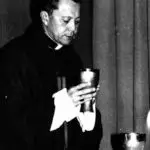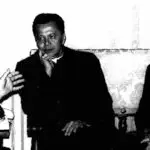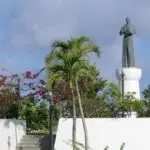Archbishop Felixberto C. Flores



Table of Contents
Share This
First Chamorro Bishop
Archbishop Felixberto C. Flores (1921 – 1985) was the first Chamorro/CHamoru bishop. He was born Felixberto Camacho Flores on 13 January 1921, in Hagåtña, the son of León Flores of Laoag, Ilocos Norte, Philippines, and Ana Martínez Camacho of Hagåtña. He attended the Guam Institute, a private school in Hagåtña run by Nieves M. Flores, and graduated as valedictorian of his class in 1938.
The following year, Flores embarked on the USS Gold Star bound for Manila, where he enrolled at the Ateneo de Manila, a Jesuit university, intending to become an engineer. He finished his first year with high honors.
Chose life of religion
Despite what seemed to be the potential for a successful secular career, Flores left the Ateneo and chose, instead, to pursue the priesthood. The Jesuits were an attractive option, but Flores wanted to serve the church in Guam, and so he became a candidate for the diocesan priesthood. Flores entered San Jose Seminary in Manila in 1940. The seminary, run by the Jesuits, was the same institution where three earlier Chamorro priests attended: Fathers Jesus Duenas, Oscar Calvo and Jose Manibusan.
When World War II broke out in December 1941, classes at the Seminary were temporarily stopped. Classes eventually resumed until 1945 when the American advance in the Pacific came close to the Philippines. The Japanese interned all Americans, and others, at the Santo Tomas University concentration camp, and Flores was among them.
Education after WWII
After the war, Flores changed seminaries and entered Saint John’s Seminary in Brighton, Massachusetts, the diocesan seminary for the Archdiocese of Boston. Two years before he finished at Brighton, Flores started taking educational administration classes at Fordham University in New York. Flores was one of an outstanding vanguard of young Chamorro men and women who attended educational institutions of higher learning in the US mainland immediately following the WWII. Many later became leaders in Guam.
Ordination
On 30 April 1949, Flores was ordained a priest in the Agana Cathedral by Bishop Apollinaris W. Baumgartner, OFM Cap. He was the first Chamorro priest to have been partly educated in the US mainland. Baumgartner quickly put Flores’ talent and education to work. For the 20 years of his priesthood before becoming bishop, Flores was intimately tied to the central workings of the church in Guam.
He was made priest of Asan in 1949 but was then transferred as rector of the cathedral in Hagåtña in 1955. He was superintendent of Catholic Schools from 1951 to 1955 and Chancellor or the Vicariate (and then the diocese) from 1952 to 1969. He taught at the Academy of Our Lady of Guam (1949-1969), was associate editor of the diocesan paper Umatuna si Yuus (1949-1969), headed various Catholic organizations (Holy Name Society, Society for the Propagation of the Faith, and Apostleship of Prayer), and was a frequent host of Catholic television and radio programs.
Flores’ prominent role in church affairs lead him to be named a papal chamberlain a few days before the 10th anniversary of his ordination in 1959. Papal chamberlain is one of the highest honors bestowed by the Church. Flores was now called Monsignor Felixberto C. Flores. In 1963, he was given the title of domestic prelate which means he was an honorary member of the papal household.
By the year 1968, Bishop Baumgartner’s health had declined seriously enough that Archbishop George Hamilton Pearce of Suva, Fiji, was made apostolic administrator of the Diocese of Hagåtña. An apostolic administrator runs the daily affairs of a diocese when the bishop is incapacitated. In 1969, Flores took his place as apostolic administrator.
Becomes bishop in 1970
On 19 March 1970, the news was announced that Rome had nominated Flores to the episcopacy (in line to be the next Bishop). He would be given a titular see (leader of the Catholic Church in title only) but remain apostolic administrator of the Hagåtña diocese, as Bishop Baumgartner was still suffering bad health. Flores was consecrated bishop on 17 May 1970, by the apostolic delegate (the Pope’s diplomatic representative) to the United States, Archbishop Luigi Raimondi.
On 18 December 1970, Bishop Baumgartner passed away. Flores was named his successor as Bishop of the Diocese of Agana on 24 April 1971, taking effect on 15 May of that year.
Flores was to lead the Catholic Church in Guam for the next 14 years. During this time, the diocese underwent much positive development. The earlier religious orders in Guam stabilized and became semi-autonomous regions of their mainland provinces. New religious orders came to work in the diocese (the Augustinian Recollects, Good Shepherd Sisters, Dominican Sisters, Marist Brothers). Flores ordained a dozen or so Chamorro priests, both diocesan and Capuchin.
Diocesan activities, especially in religious education, received much attention and were expanded. In 1979, Flores signed the incorporation papers establishing Catholic Social Services.
One diocesan venture which became a challenge to sustain was the Medical Center of the Marianas, a Catholic hospital which Flores built in 1977 at a cost of $14 million. Within a year it became clear that the promised financial backing he was depending on was not coming through. Flores lobbied with the government to purchase the hospital, which it did in 1979. The facility then became Guam Memorial Hospital.
Flores was also very vocal on social issues, including a 1977 referendum on casino gambling. The diocese opposed casino gambling saying that it would increase crime and addiction to gambling and the voters echoed this position, defeating the proposal by a vote of three to one.
One of Flores’ largest achievements was securing the historic visit of Pope John Paul II to Guam on 22-23 February 1981. Following this event, the diocese enjoyed unprecedented attention and affirmation from Rome. On 8 December 1983, Father Anthony S. Apuron, OFM Cap, was appointed an Auxiliary Bishop to assist Flores.
From bishop to archbishop
On 8 March 1984, Rome announced that Flores was to be raised to the rank of Archbishop and the diocese as well to become a metropolitan archdiocese. The cathedral in Hagåtña was raised to the rank of Minor Basilica. In the same year, on 8 November, the Vatican announced that the Northern Marianas, which had been a part of the Archdiocese, was to be made its own diocese with its own bishop.
On 6 October 1985, Diego Luís de San Vitores was beatified in Rome. For years, Flores and others worked hard to obtain this recognition of what many recognize as the heroic virtue of an evangelist and martyr. Flores led the Guam pilgrimage to the beatification ceremonies in Rome. It was a high point in the church’s life for Flores and many Guam Catholics.
After the beatification, Flores went to San Francisco, California, to take care of his health. For years he had struggled with renal and cardiac issues. Two hours after an apparently successful open-heart surgery, he died of cardiac arrest in San Francisco on 25 October. Many remarked that at least he had seen many of his dreams for the church on Guam realized in the months and years before his death. He was buried in the sanctuary of the Dulce Nombre de María Cathedral-Basilica.
For further reading
Capuchin Franciscan Friars. “Home.”
Catholic Social Service: Catholic Charities Guam. “Catholic Charities, Social Service Home.”
